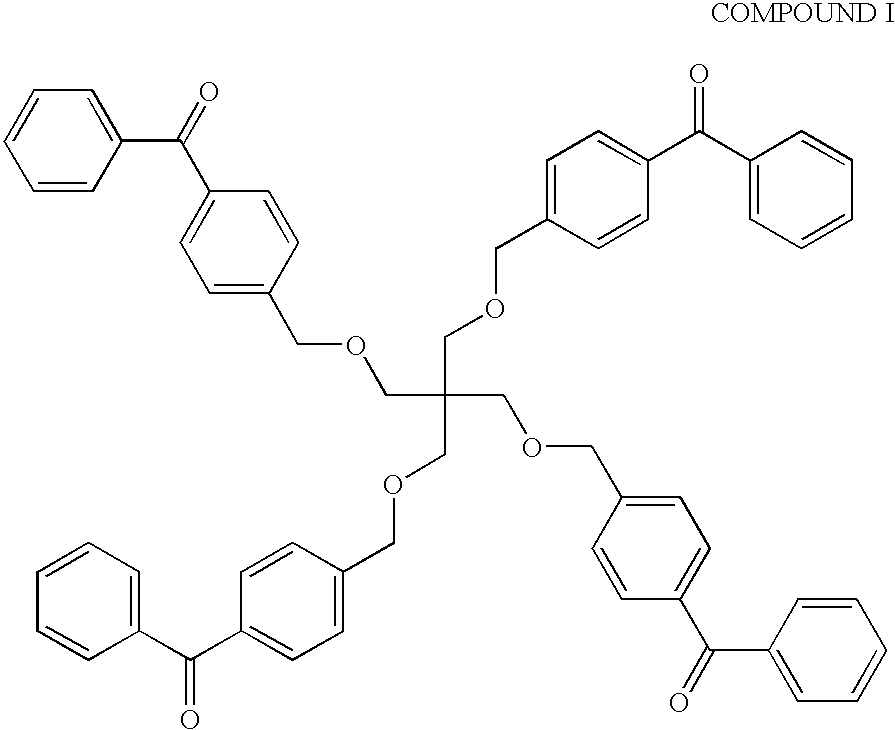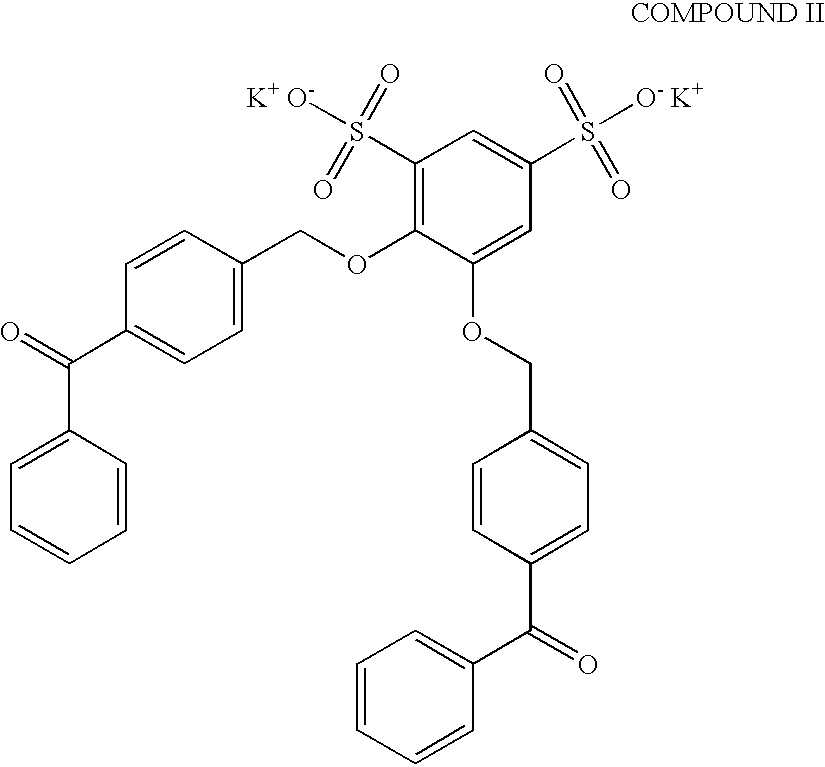Reagent and method for providing coatings on surfaces
a technology of surface coating and reagent, which is applied in the field of reagent and method for providing coating, can solve the problems of lack of such attributes as speed, versatility and ease of use, loss of desirable (e.g., biological) activity, and lack of teachings in the art regarding either the ability or desirability of providing polymeric coating on such devices, so as to improve coating efficiency and improve control over the in situ polymerization process.
- Summary
- Abstract
- Description
- Claims
- Application Information
AI Technical Summary
Benefits of technology
Problems solved by technology
Method used
Image
Examples
example 2
Surface Modification of Polyether Block Amide (PEBAX) by Application of Acrylamide / AMPS with Compound I
[0095] A coating solution was prepared by dissolving Compound I as described in Example 1. PEBAX rods (5 cm O.D. 118, Light Blue, 20% Barium Sulfate, Medical Profiles Inc.) were coated as described in Example 1 except the rods were allowed to soak for approximately 30 minutes in Compound I coating solution. The results for lubricity / durability and bacterial adherence are shown on Table 1 and Table 2, respectively. The results shown in Table 1 indicate that the applied coating improved the lubricity of the rods as compared to uncoated controls. The results of Table 2 indicated that the control rods were not adherent to the three organisms tested, as compared to uncoated rods.
example 3
Surface Modification of Silicone Rubber (SR) by Application of Acrylamide / AMPS with Compound I
[0096] A coating solution containing Compound I was prepared as described in Example 1. SR rods (5 cm, SSF-19ETD-750, Specialty Silicone Fabricators) were coated by the same procedure as in Example 1 with the following exceptions. The SR rods to be coated were sonicated in an IPA solution for at least 10 minutes. After sonication, the rods were allowed to dry for 2 to 3 hours. The rods were also cleaned with an IPA-soaked lint-free cloth prior to coating with Compound I coating solution. The SR rods were allowed to soak for approximately 30 minutes in the Compound I coating solution. The experimental results for both lubricity / durability and bacterial adherence properties are shown in Table 1 and Table 2, respectively. The results shown in Table 1 and Table 2 indicate that the coated rods were more lubricious and significantly less adherent to the three organisms as compared with uncoated c...
example 4
Surface Modification and Analysis of Low Density Polyethylene (LDPE) by Application of Acrylamide / AMPS with Compound I
[0097] Low density polyethylene (LDPE) was precoated with a solution containing Compound I. The polyethylene substrate was obtained as flat sheets (0.3 / mm thick), and used as 1 / 2 inch diameter disks. The coating solution of Compound I was prepared and coated on the LDPE surface as described in Example 1. After precoating, the LDPE disks were coated with acrylamide / AMPS as previously described (Example 1), after which the coated LDPE pieces were stained in 0.1% Toluidine Blue (Sigma, PN:T3260) for approximately 60 seconds. Visual examination revealed that the coated LDPE material was evenly stained blue, indicating an even and uniform coating. The coated samples were then tested for hemocompatibility using the protocols described below.
Platelet Attachment and Activation from Platelet Rich Plasma
[0098] Various samples of the surface-modified materials described above w...
PUM
| Property | Measurement | Unit |
|---|---|---|
| thickness | aaaaa | aaaaa |
| solubility | aaaaa | aaaaa |
| wavelength range | aaaaa | aaaaa |
Abstract
Description
Claims
Application Information
 Login to View More
Login to View More - R&D
- Intellectual Property
- Life Sciences
- Materials
- Tech Scout
- Unparalleled Data Quality
- Higher Quality Content
- 60% Fewer Hallucinations
Browse by: Latest US Patents, China's latest patents, Technical Efficacy Thesaurus, Application Domain, Technology Topic, Popular Technical Reports.
© 2025 PatSnap. All rights reserved.Legal|Privacy policy|Modern Slavery Act Transparency Statement|Sitemap|About US| Contact US: help@patsnap.com



